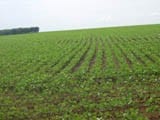 Souza Jr., C. 2005.
Souza Jr., C. 2005.
Large forested areas have recently been impoverished by degradation caused by selective logging, forest fires and fragmentation in the Amazon region, causing partial change of the original forest structure and composition. As opposed to deforestation that has been monitored with Landsat images since the late 70’s, degraded forests have not been monitored in the Amazon region. In this dissertation, remote sensing techniques for identifying and mapping unambiguously degraded forests with Landsat images are proposed. The test area was the region of Sinop, located in the state of Mato Grosso, Brazil. This region was selected because a gradient of degraded forest environments exist and a robust time-series of Landsat images and forest transect data were available. First, statistical analyses were applied to identify the best set of spectral information extracted from Landsat images to detect several types of degraded forest environments. Fraction images derived from Spectral Mixture Analysis (SMA) were the best type of information for that purpose. A new spectral index based on fraction images – Normalized Difference Fraction Index (NDFI) – was proposed to enhance the detection of canopy damaged areas in degraded forests. Second, a contextual classification algorithm was implemented to separate unambiguously forest degradation caused by anthropogenic activities from natural forest disturbances. These techniques were validated using forest transects and high resolution aerial videography images and proved to be highly accurate. Next, these techniques were applied to a time-series data set of Landsat images, encompassing 20 years, to evaluate the relationship between forest degradation and deforestation. The most important finding of the forest change detection analysis was that forest degradation and deforestation are independent events in the study area, making worse the current forest impacts in the Amazon region. Finally, the techniques developed and tested in the Sinop region were successfully applied to forty Landsat images covering other regions of the Brazilian Amazon. Standard fractions and NDFI images were computed for these other regions and both physically and spatially consistent results were obtained. An automated decision tree classification using genetic algorithm was implemented successfully to classify land cover types and sub-classes of degraded forests. The remote sensing techniques proposed in this dissertation are fully automated and have the potential to be used in tropical forest monitoring programs.
